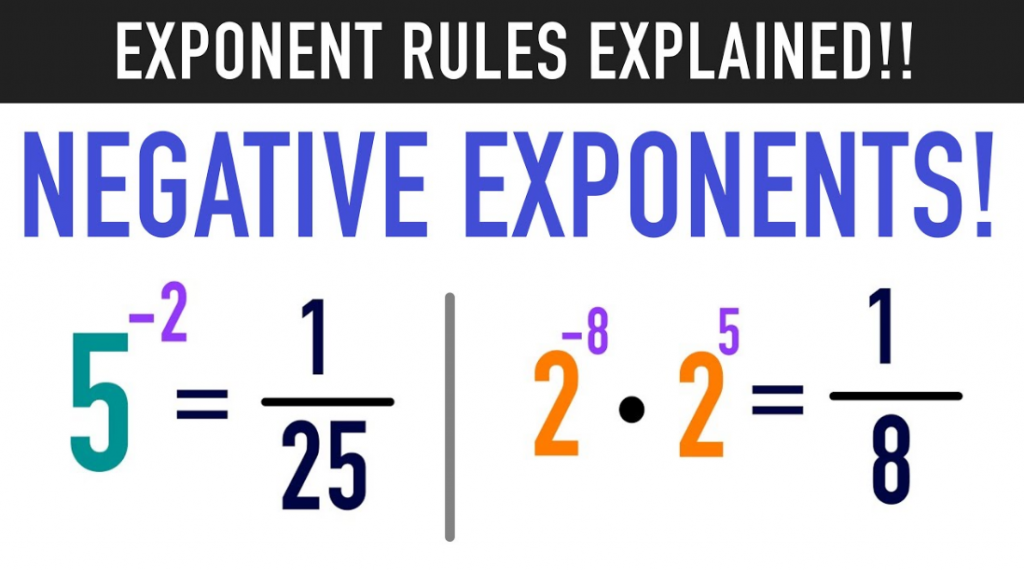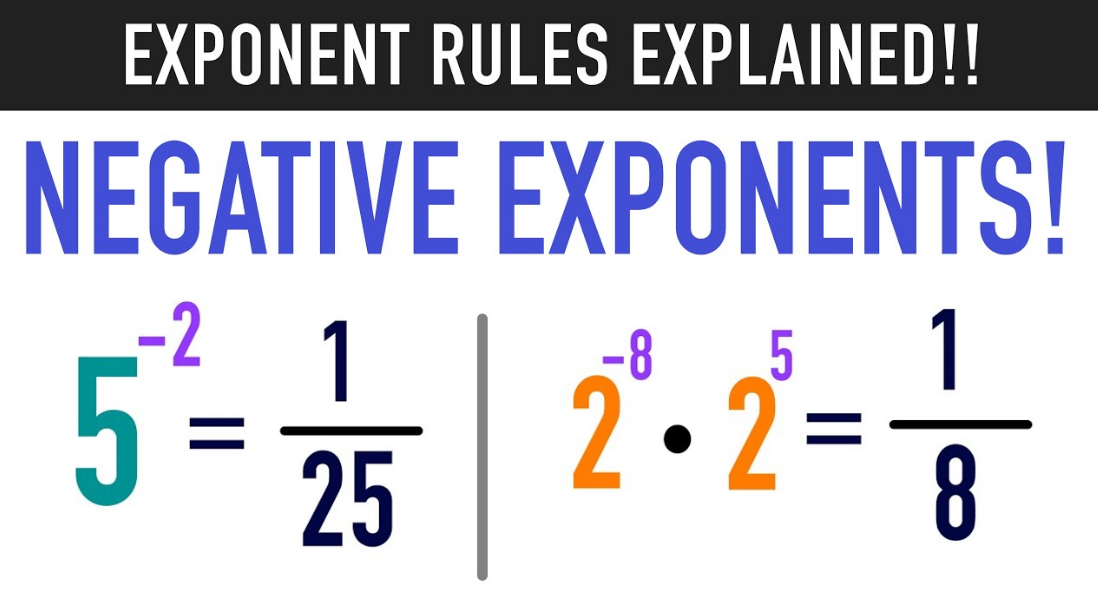The negative exponent Rule tells us that the power of a number is negative and it applies to its reciprocal. When a number is multiplied by itself, it is called an exponent. For example, 32 = 3 × 3. When we have positive exponents, it is easy to multiply the number (base) by itself, but what happens when we have negative exponents?
Negative exponents are defined as the multiplicative inverse of the base raised to the power opposite that which is given. Essentially, we write the reciprocal of the number and then solve it like a positive exponent. For instance, (2/3)-2 can be written as (3/2)2.

Table of Contents
What are Negative Exponents?
Exponents indicate how many times you should multiply a base number. For instance, consider 82, 8 is the base, and 2 is the exponent.
We know that 82 = 8 × 8. We know the reciprocal of the base is multiplied by a negative exponent when we have a negative exponent. Count the 8-2, here, the base is 8 and we have a negative exponent (-2). 8-2 is expressed as 1/82 = 1/8×1/8.
Numbers and Expressions with Negative Exponents
Here are some examples of negative exponents with variables and numbers. See how the number is written in its reciprocal form and how the sign of the powers changes in the table.
Negative Exponent Rules
Negative exponents follow the same rules as everything else in math class. The seven laws of exponents are summarized here if you need a refresher:
- Product of powers: Multiply powers together when multiplying like bases
- Quotient of powers rule: When dividing like bases, subtract powers
- Power of powers rule: Multiply powers together when raising a power by another exponent
- Power of a product rule: Distribute power to each base when multiplying several variables
- Power of a quotient rule: Assign power to each base when multiplying several variables
- Zero power rule: Increase any base to the power of 0 to make it one
- Negative exponent rule: To turn a negative exponent into a positive one, flip it into a reciprocal.
The process of simplification is made easier by a set of rules or laws for negative exponents. The following are the basic rules for solving negative exponents.
- Rule 1: The negative exponent rule states that for each number ‘a’ with the negative exponent -n, take the reciprocal of the base and multiply it according to the value of the exponent: a(-n)=1/an=1/a×1/a×….n times
- Rule 2: The rule for a negative exponent in the denominator suggests that for each number ‘a’ in the denominator and its negative exponent -n, the result can be written as: 1/a(-n)=an=a×a×….n times
Let’s apply these rules to numbers and see how they work.
Example 1: Solve: 2-2 + 3-2
Solution:
- Use the negative exponent rule a-n=1/an
- 2-2 + 3-2 = 1/22 + 1/32 = 1/4 + 1/9
- Take the Least Common Multiple (LCM): (9+4)/36 = 13/36
Therefore, 2-2 + 3-2 = 13/36
Example 2: Solve: 1/4-2 + 1/2-3
Solution:
- Use the second rule with a negative exponent in the denominator: 1/a-n =an
- 1/4-2 + 1/2-3 = 42 + 23 =16 + 8 = 24
Therefore, 1/4-2 + 1/2-3 = 24.
Why are Negative Exponents Fractions?
With a negative exponent, we get the inverse of the number. In other words, a-n = 1/an and 5-3 becomes 1/53 = 1/125. A negative exponent changes fractions to numbers. To see how fractions change from negative exponents, let’s take another example.
Example: Solve 2-1 + 4-2
Solution:
2-1 can be written as 1/2 and 4-2 is written as 1/42. When the sign of an exponent changes, negative exponents become fractions.
Multiplying Negative Exponents
Multiplying negative exponents is the same as multiplying any other number. After they are converted to fractions, negative exponents become easy to solve because they can be expressed as fractions. Using the same rules we use to multiply positive exponents, we multiply negative exponents. The following example shows how to multiply negative exponents.
Example: Solve: (4/5)-3 × (10/3)-2
- We should start by writing the expression in its reciprocal form, which makes the negative exponent positive: (5/4)3×(3/10)2
- Now open the brackets: 53×3243×10253×3243×102(∵102=(5×2)2 =52×22)
- Check the common base and simplify: 53×32×5−243×2253×32×5−243×22
- 5×3243×45×3243×4
- 45/44 = 45/256
How to Solve Negative Exponents?
Solving equations or expressions requires operating on them. Solving negative exponents also involves simplifying terms with negative exponents and applying the given arithmetic operations.
Example: Solve: (73) × (3-4/21-2)
Solution:
After converting all the negative exponents to positive exponents, we simplify
- Given: 73×3−421−273×3−421−2
- Convert the negative exponents to positive by writing the reciprocal of the particular number:73×2123473×21234
- Use the rule: (ab)n = an × bn and split the required number (21).
- 73×72×323473×72×3234
- Use the rule: am × an = a(m+n) to combine the common base (7).
- 75/32 =16807/9
Important Notes:
We should remember the following points when using negative exponents.
- An exponent or power is the number of times the base has to be multiplied by itself.
am = a × a × a ….. m times
a-m = 1/a × 1/a × 1/a ….. m times - a-n is also known as the multiplicative inverse of an.
- If a-m = a-n then m = n.
- The relation among the exponent (positive powers) and the negative exponent (negative power) is expressed as ax=1/a-x

